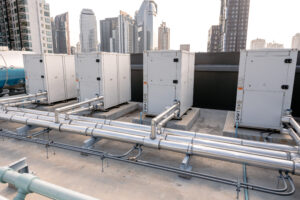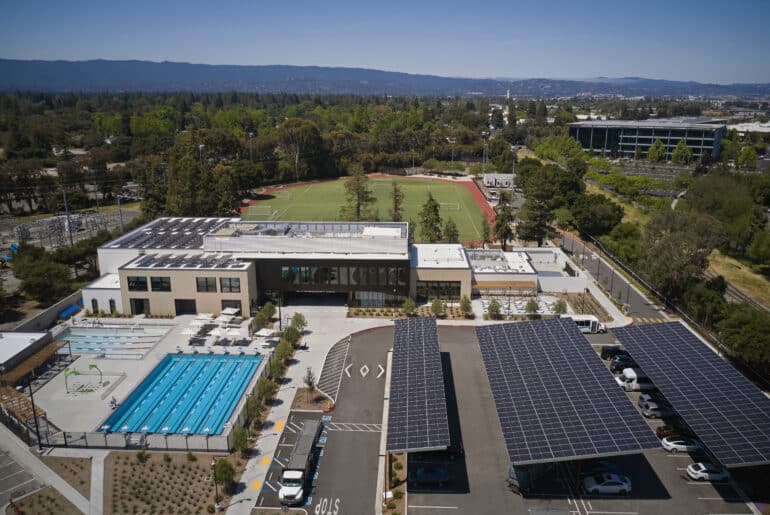The next generation of green building certification is here. Released in April 2025, LEED v5 introduces powerful updates that shift the industry toward carbon reduction, energy performance, and electrification. Previous versions will be sunset by the end of Q1 2026, making now the time to understand what’s changed and how your project can benefit.
LEED v5 is a game-changer for Energy and Atmosphere (EA) credits. A sizeable evolution from past versions of LEED, these credits are an incredibly complex suite of interrelated requirements designed to drive energy efficiency and decarbonization. Here’s what design teams and project managers need to know to stay ahead of the curve.

#1: CARBON REDUCTION TAKES CENTER STAGE
LEED v5’s most transformative update is its explicit prioritization of carbon reduction. The new Operational Carbon Projection and Decarbonization Plan prerequisite (EAp1) embeds long-term operational carbon management into every project. Teams now need to develop and document a 25-year decarbonization strategy, requiring them to think beyond design and construction into ongoing performance. This marks a fundamental shift in how projects are designed, moving from short-term efficiency to sustained decarbonization.
This shift continues through the credits:
-
- Electrification is elevated through the new Electrification credit (EAc1). Eliminating on-site combustion (with exceptions for emergency systems) can earn valuable points while positioning buildings for the future. Expect to see more all-electric systems, such as heat pumps for HVAC and service hot water heating (SHW), as well as electric cooking and processes. Electrification aligns projects with stricter regulations and a decarbonizing utility grid, in addition to many owner commitments to portfolio decarbonization.
-
- Renewable energy expectations are also significantly strengthened in LEED v5 through the Renewable Energy credit (EAc4), creating a deeper synergy with the Enhanced Energy Efficiency credit (EAc3). Projects pursuing net-zero site energy through on-site or off-site renewables like solar or wind can maximize points while reducing operating costs. In addition, LEED v5 raises the baseline to ASHRAE 90.1-2019 or 2022, meaning the performance bar is higher—and the benefits of renewable energy integration are even greater.

#2: ENERGY MODELING IS STILL YOUR TOP TOOL
Energy modeling remains a critical tool for unlocking the full potential of energy efficiency and decarbonization under LEED v5. While this version places simulation-based performance compliance and prescriptive compliance on more equal footing—each now worth up to 10 points under Enhanced Energy Efficiency (EAc3), compared to just 6 out of 18 points available under LEED v4.1—performance compliance (energy modeling) continues to provide unique strategic advantages:
-
- Providing integrated analysis of building design and energy performance.
-
- Enabling design flexibility and cost optimization.
-
- Unlocking cross-credit alignment between Operational Carbon Projection and Decarbonization Plan (EAp1), Electrification (EAc1), Reduce Peak Thermal Loads (EAc2), and Renewable Energy (EAc4).
#3: PLATINUM PROJECTS DEMAND ALL-ELECTRIC, NET ZERO DESIGN
Aiming for Platinum certification? Prepare for a new bar. LEED v5 introduces stringent new requirements for the Platinum level, including full Electrification (EAc1) and 100% energy offset through Tier 1 or Tier 2 Renewable Energy (EAc4) sources.
In essence, Platinum under LEED v5 now mandates all-electric, net-zero energy buildings.
Energy modeling again plays a crucial role. Projects must earn at least eight points under the Enhanced Energy Efficiency credit (EAc3) to stay on track for Platinum. Energy modeling streamlines the Platinum pathway by integrating the impacts of electrification and renewable energy systems into building performance analysis. Without energy modeling, teams need to implement additional strategies for reducing plug and process loads, which is often challenging, especially during design phases where exact tenant programming is not fully determined.
READY FOR LEED V5?
LEED v5 represents more than an update—it’s a mindset shift toward deeper decarbonization, electrification, and climate accountability. For AEC teams, it’s a maze of new prerequisites and cross-credit dependencies.
At Stok, we make it simple. We’ve helped clients anticipate change through every LEED evolution, and now we’re doing the same for LEED v5. Our experts manage the complexity to help teams find the most cost-effective and impactful paths to optimizing prerequisites and credits while adding value to the building design.
Ready to elevate your project with LEED v5? Reach out to our team to unlock new levels of efficiency and performance, and help you lead with confidence in the era of carbon-conscious design.



